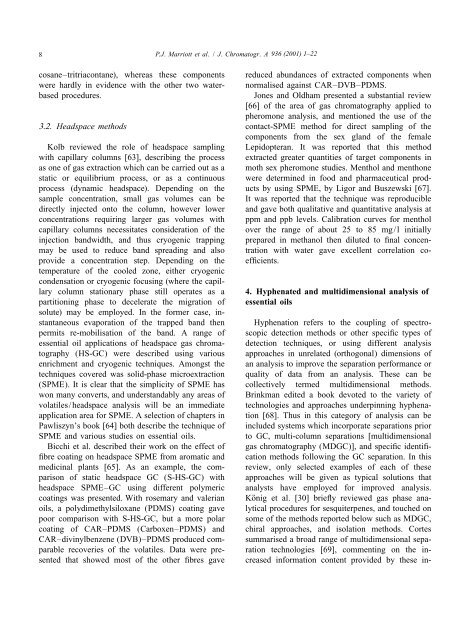Gas chromatographic technologies for the analysis of essential oils
Gas chromatographic technologies for the analysis of essential oils
Gas chromatographic technologies for the analysis of essential oils
Create successful ePaper yourself
Turn your PDF publications into a flip-book with our unique Google optimized e-Paper software.
8 P.J. Marriott et al. / J. Chromatogr. A 936 (2001) 1–22<br />
cosane–tritriacontane), whereas <strong>the</strong>se components<br />
were hardly in evidence with <strong>the</strong> o<strong>the</strong>r two waterbased<br />
procedures.<br />
reduced abundances <strong>of</strong> extracted components when<br />
normalised against CAR–DVB–PDMS.<br />
Jones and Oldham presented a substantial review<br />
[66] <strong>of</strong> <strong>the</strong> area <strong>of</strong> gas chromatography applied to<br />
pheromone <strong>analysis</strong>, and mentioned <strong>the</strong> use <strong>of</strong> <strong>the</strong><br />
3.2. Headspace methods contact-SPME method <strong>for</strong> direct sampling <strong>of</strong> <strong>the</strong><br />
components from <strong>the</strong> sex gland <strong>of</strong> <strong>the</strong> female<br />
Kolb reviewed <strong>the</strong> role <strong>of</strong> headspace sampling Lepidopteran. It was reported that this method<br />
with capillary columns [63], describing <strong>the</strong> process extracted greater quantities <strong>of</strong> target components in<br />
as one <strong>of</strong> gas extraction which can be carried out as a moth sex pheromone studies. Menthol and menthone<br />
static or equilibrium process, or as a continuous were determined in food and pharmaceutical prodprocess<br />
(dynamic headspace). Depending on <strong>the</strong> ucts by using SPME, by Ligor and Buszewski [67].<br />
sample concentration, small gas volumes can be It was reported that <strong>the</strong> technique was reproducible<br />
directly injected onto <strong>the</strong> column, however lower and gave both qualitative and quantitative <strong>analysis</strong> at<br />
concentrations requiring larger gas volumes with ppm and ppb levels. Calibration curves <strong>for</strong> menthol<br />
capillary columns necessitates consideration <strong>of</strong> <strong>the</strong> over <strong>the</strong> range <strong>of</strong> about 25 to 85 mg/l initially<br />
injection bandwidth, and thus cryogenic trapping prepared in methanol <strong>the</strong>n diluted to final concenmay<br />
be used to reduce band spreading and also tration with water gave excellent correlation coprovide<br />
a concentration step. Depending on <strong>the</strong> efficients.<br />
temperature <strong>of</strong> <strong>the</strong> cooled zone, ei<strong>the</strong>r cryogenic<br />
condensation or cryogenic focusing (where <strong>the</strong> capillary<br />
column stationary phase still operates as a 4. Hyphenated and multidimensional <strong>analysis</strong> <strong>of</strong><br />
partitioning phase to decelerate <strong>the</strong> migration <strong>of</strong> <strong>essential</strong> <strong>oils</strong><br />
solute) may be employed. In <strong>the</strong> <strong>for</strong>mer case, instantaneous<br />
evaporation <strong>of</strong> <strong>the</strong> trapped band <strong>the</strong>n Hyphenation refers to <strong>the</strong> coupling <strong>of</strong> spectropermits<br />
re-mobilisation <strong>of</strong> <strong>the</strong> band. A range <strong>of</strong> scopic detection methods or o<strong>the</strong>r specific types <strong>of</strong><br />
<strong>essential</strong> oil applications <strong>of</strong> headspace gas chroma- detection techniques, or using different <strong>analysis</strong><br />
tography (HS-GC) were described using various approaches in unrelated (orthogonal) dimensions <strong>of</strong><br />
enrichment and cryogenic techniques. Amongst <strong>the</strong> an <strong>analysis</strong> to improve <strong>the</strong> separation per<strong>for</strong>mance or<br />
techniques covered was solid-phase microextraction quality <strong>of</strong> data from an <strong>analysis</strong>. These can be<br />
(SPME). It is clear that <strong>the</strong> simplicity <strong>of</strong> SPME has collectively termed multidimensional methods.<br />
won many converts, and understandably any areas <strong>of</strong> Brinkman edited a book devoted to <strong>the</strong> variety <strong>of</strong><br />
volatiles/headspace <strong>analysis</strong> will be an immediate <strong>technologies</strong> and approaches underpinning hyphenaapplication<br />
area <strong>for</strong> SPME. A selection <strong>of</strong> chapters in tion [68]. Thus in this category <strong>of</strong> <strong>analysis</strong> can be<br />
Pawliszyn’s book [64] both describe <strong>the</strong> technique <strong>of</strong> included systems which incorporate separations prior<br />
SPME and various studies on <strong>essential</strong> <strong>oils</strong>.<br />
to GC, multi-column separations [multidimensional<br />
Bicchi et al. described <strong>the</strong>ir work on <strong>the</strong> effect <strong>of</strong> gas chromatography (MDGC)], and specific identififibre<br />
coating on headspace SPME from aromatic and cation methods following <strong>the</strong> GC separation. In this<br />
medicinal plants [65]. As an example, <strong>the</strong> com- review, only selected examples <strong>of</strong> each <strong>of</strong> <strong>the</strong>se<br />
parison <strong>of</strong> static headspace GC (S-HS-GC) with approaches will be given as typical solutions that<br />
headspace SPME–GC using different polymeric analysts have employed <strong>for</strong> improved <strong>analysis</strong>.<br />
coatings was presented. With rosemary and valerian Konig ¨ et al. [30] briefly reviewed gas phase ana<strong>oils</strong>,<br />
a polydimethylsiloxane (PDMS) coating gave lytical procedures <strong>for</strong> sesquiterpenes, and touched on<br />
poor comparison with S-HS-GC, but a more polar some <strong>of</strong> <strong>the</strong> methods reported below such as MDGC,<br />
coating <strong>of</strong> CAR–PDMS (Carboxen–PDMS) and chiral approaches, and isolation methods. Cortes<br />
CAR–divinylbenzene (DVB)–PDMS produced com- summarised a broad range <strong>of</strong> multidimensional sepaparable<br />
recoveries <strong>of</strong> <strong>the</strong> volatiles. Data were pre- ration <strong>technologies</strong> [69], commenting on <strong>the</strong> insented<br />
that showed most <strong>of</strong> <strong>the</strong> o<strong>the</strong>r fibres gave creased in<strong>for</strong>mation content provided by <strong>the</strong>se in-











![Bericht von Schimmel & Co. [Inhaber Gebr. Fritzsche] in Leipzig](https://img.yumpu.com/24438150/1/171x260/bericht-von-schimmel-co-inhaber-gebr-fritzsche-in-leipzig.jpg?quality=85)




